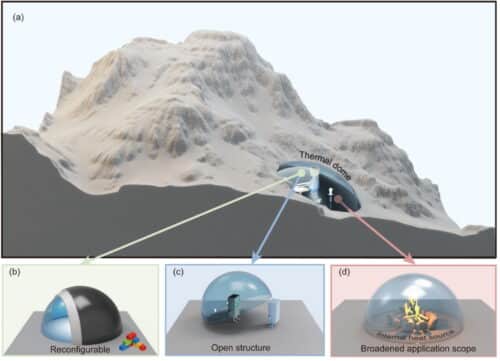A novel thermal dome design from China advances thermal invisibility by offering practical, reconfigurable solutions for engineering applications.

A unique thermal dome concept developed by a team of researchers from Zhejiang University, Fudan University and Graduate School of China Academy of Engineering Physics, China marks a pivotal moment in thermal invisibility technology. The research addresses challenges in traditional thermal cloaking devices, presenting a practical and adaptable approach to heat management.
Thermal invisibility, a long-sought feature of thermal metamaterials, allows heat flow control to render objects invisible to heat detection. Despite progress, conventional cloaks remain impractical due to their fully enclosed designs, rigidity, and inability to function effectively around heat sources. These limitations have hindered their adoption in real-world applications.
The thermal dome concept introduces an open, semi-ellipsoidal design that ensures usability even for objects emitting heat. Described as “reconfigurable and inspired by Lego blocks,” it simplifies adaptation to diverse environments and improves practicality. Industries requiring advanced thermal regulation, such as electronics, aerospace, and defense, could find the dome particularly valuable for preventing heat signatures from compromising sensitive equipment. Its versatility also holds potential in research and development settings for engineers and scientists exploring innovative heat management solutions.
The theoretical framework behind the thermal dome involved solving differential equations to determine precise conditions for invisibility. The design incorporates specific relationships between the thermal conductivities of its components which are the dome, the core, and the surrounding medium, making there a seamless heat distribution. The semi-ellipsoidal shape was chosen for its symmetry and adaptability, meeting stringent engineering demands.
Simulations and experiments confirmed the effectiveness of the thermal dome. Using COMSOL multiphysics software, researchers validated its theoretical foundation through finite-element modeling. Experimental studies with hemispherical domes further demonstrated their capability to shield objects and stabilize internal temperatures under various thermal conditions.
By overcoming the limitations of previous designs, this study sets a new benchmark for practicality and scalability in thermal invisibility technologies. The researchers’ achievements open avenues for future exploration and innovation in multiple scientific domains, including electric and magnetic field cloaking.






